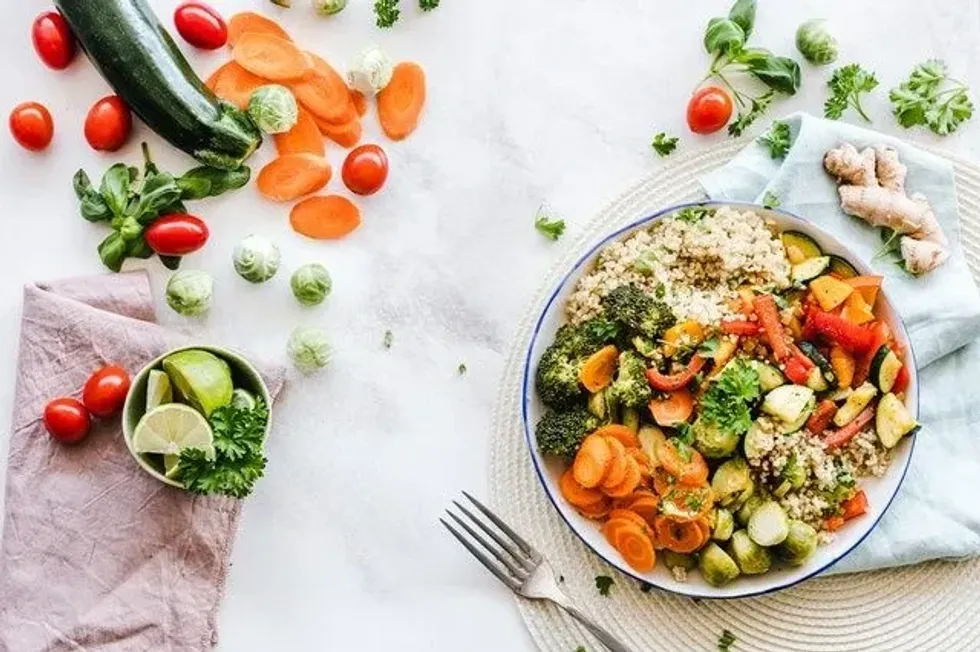From finding your 'morning' sickness only pops up at night to wondering if you're allowed a glass of wine at your friend's birthday, pregnancy is full of questions and surprises.
One unpleasant surprise for about 10% of pregnant women is suddenly developing something called gestational diabetes. In this article, we fill you in on everything you need to know about what gestational diabetes is, the blood glucose test, and what to eat if you've been diagnosed.
What Is Gestational Diabetes?
Gestational diabetes means a pregnant woman develops diabetes for the first time while she is carrying the baby. Like all forms of diabetes, it's caused by the body not being able to produce enough insulin to control blood glucose.
Blood glucose is the sugar that absorbs into your bloodstream from your food.
From there, insulin from your pancreas normally helps the glucose move into your cells, which use it for energy. When there is too little insulin, the sugar stays in your bloodstream and you get hyperglycemia (high blood sugar), a symptom of diabetes.
Gestational diabetes is most common at between 24-28 weeks pregnant. Signs of gestational diabetes can include increased thirst, tiredness, and blurry vision. However, many women have no symptoms at all. That's why most healthcare providers automatically perform a glucose test during your regular prenatal health checkup.
There are many risk factors for developing gestational diabetes, such as having gestational diabetes during a previous pregnancy, being overweight, having a family history of diabetes, and having medical conditions like PCOS or metabolic syndrome.
If left untreated, it can lead to an increased risk of developing pre-eclampsia (high blood pressure) as well as a risk of the baby growing so big that you need a Cesarean section.
Gestational diabetes often goes away after you give birth, but as many as half of all women who have it later go on to develop Type 2 diabetes. This means it's important to keep getting screened regularly if you've been diagnosed with gestational diabetes.
What Is The Glucose Tolerance Test

The glucose test during pregnancy is a way of screening for gestational diabetes. Doctors also use this test to diagnose diabetes and pre-diabetes (glucose intolerance). It measures how well your body processes sugars.
It's important to mention here that 'passing' and 'failing' the test are slightly misleading terms. The test is only there to show your doctor how to best support your health. A blood glucose result outside the healthy range is not a failure; it just means you have a health condition.
Now we've got that out of the way, on to the tests.
There are two types of glucose tolerance tests to diagnose gestational diabetes: the one-hour glucose test and the three-hour glucose test. Most doctors will start with the one-hour test and move on to the three-hour one if you have a result outside the normal range or have other risk factors.
The CDC recommends following your usual diet leading up to your first blood glucose test. Before either type of glucose tolerance test, you will be asked to fast (avoid consuming food or liquids other than water) for eight to 12 hours. This is so doctors can see what your normal blood glucose level is like.
During the test, doctors will take a blood sample. They'll then ask you to drink a sugary drink.
After an hour, another blood sample is taken. If your body is processing sugar normally, your blood test results will show your blood glucose level rising then quickly decreasing again as your cells absorb the sugar.
If you are not producing enough insulin, the results will show that your blood glucose level has remained higher than normal. You may then be given a three-hour test, where your blood sugar levels are measured hourly for three hours after you have the drink.
Ideal Diet For Gestational Diabetes
If your glucose test shows you have gestational diabetes, you may be prescribed insulin. Otherwise, your doctor will recommend you follow a diet designed to help you maintain a normal blood glucose level for the rest of your pregnancy. Most doctors will also recommend light exercises like walking for 30 minutes a day to help control blood sugar levels.
Your doctor will probably refer you to a specialist dietitian if your test results show you have gestational diabetes. They'll be able to build a meal plan that works for you, taking into account dietary advice for pregnancy, the need to stabilize your blood glucose, any food allergies, intolerances, or dietary restrictions, and of course, your tastes.
The ideal diet for gestational diabetes is similar to the recommended diet for Type 2 diabetes.
However, there are some important modifications to allow for the different nutritional needs a pregnant woman has. To make sure your gestational diabetes diet suits your needs and your baby's, it's always best to follow your doctor or dietitian's advice.
Here are our top tips for the ideal diet to manage blood glucose during pregnancy.
Eat Little And Often: Some experts suggest eating four times a day, while others suggest three meals and two or three snacks. Either way, eating regularly, not skipping meals, and avoiding eating too much at once are key.
Eating too much at once will release too much sugar and send your glucose levels soaring while skipping meals can lead to hypoglycemia (low blood sugar) and giving in to the temptation to stuff yourself because you're so hungry.
Swap High-GI Foods For Lower-GI Ones: The glycemic index (GI) measures how quickly sugar is released into your bloodstream after you eat a certain food. High-GI foods like cakes, breakfast cereals, and sugary drinks release large amounts of sugar into your bloodstream very quickly, sending your glucose levels through the roof.
Good replacements are wholegrains and pulses as well as low-GI vegetables and fruits.
Eat Healthy Fats: Foods that are high in healthy fats like olive oil, avocado, and eggs can help you feel full for longer after you eat. Eating the correct amount of these foods will help you resist the temptation to overeat or snack on sugary foods.
Watch What You Drink: It goes without saying that sugary sodas are off the menu while you're managing gestational diabetes. However, even seemingly healthy choices like milk and fruit juice can contain lots of hidden sugar. To avoid unnecessary glucose spikes, water is the best bet.
Sample Meal Plans

Sticking to a healthy diet will help you pass the glucose tolerance test. Adjusting to a whole new way of eating is already tough, let alone when you've got pregnancy cravings to contend with. That's why we've put together some ideas to help you make healthy changes.
You may still need to alter your diet as your pregnancy progresses, some women find that different foods work for them at different times in their pregnancy, so staying flexible is key. And of course, any gestational diabetes meal plan should be discussed with your doctor and dietitian.
Day 1
Breakfast: Oatmeal. Half a cup of rolled oats, one cup of water or fat-free milk, one tsp honey, and a shake of cinnamon.
Snack: Two to three tbsp nut butter with one sliced apple.
Lunch: Sandwich with a side salad. Two slices wholemeal bread, three oz turkey, chicken or plant protein, salad veggies, one to two tbsp diabetes-friendly salad dressing.
Snack: A quarter of a cup of diced pineapple and one rice cake.
Dinner: Tofu stir fry. Two oz cubed firm tofu, one cup stir fry veg mix, three tbsp stir fry sauce, and two-thirds of a cup of brown rice.
Day 2
Breakfast: Boiled egg. One slice of wholegrain toast, one boiled egg, and one cup fat-free milk.
Snack: One cup vegetable batons with half a cup hummus.
Lunch: Italian bean soup. Two oz white beans, two oz canned tomatoes, one cup of vegetable broth, one cup of chopped carrot, celery, and kale, with onion, garlic, and Italian herbs to taste.
Snack: Handful of almonds, half a banana.
Dinner: Mexican chicken with rice and beans. Half a cup boiled rice, half a cup pinto beans, four oz sliced chicken breast sautéed with two-thirds of a cup of mixed onion and bell peppers.
Day 3
Breakfast: Chia pudding. One-quarter of a cup of chia seeds, half a cup almond milk, one cup mixed berries.
Snack: Five wholewheat crackers with one oz cheese.
Lunch: Poached salmon salad. Two and a half oz poached salmon, salad vegetables, and one to two tbsp vinaigrette dressing.
Snack: Two cups air-popped popcorn with cracked black pepper, chili powder, and lime zest, or folic acid-rich nutritional yeast.
Dinner: Zoodle bolognese. Two cups zucchini noodles, two oz ground turkey, one oz chopped mushrooms, one cup spinach, and one cup canned diced tomatoes, with onion, garlic, and Italian herbs to taste.
Day 4
Breakfast: Egg and spinach toast. One slice wholegrain toast, one poached egg, half a cup spinach. Or sub out the egg for avocado.
Snack: One cup plain yogurt with half a cup berries and two tbsp chopped nuts.
Lunch: Lentil and quinoa salad. Two oz cooked quinoa, one oz puy lentils, seven halved cherry tomatoes, one chopped spring onion, and two tbsp vinaigrette dressing.
Snack: Wholewheat crackers, half a cup cottage cheese, and half a cup grapes.
Dinner: Four oz skinless chicken breast, five oz baked potato, one cup steamed broccoli, and one low-carb diabetic cookie.
If you found this article helpful, then why not take a look at what to do if you have no morning sickness or find out all about ovarian cysts during pregnancy?










